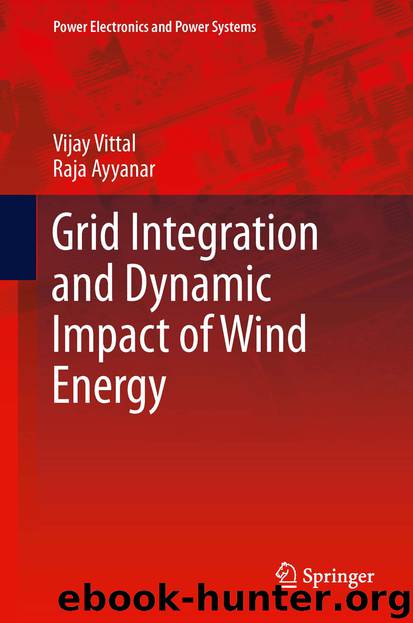Grid Integration and Dynamic Impact of Wind Energy by Vijay Vittal & Raja Ayyanar

Author:Vijay Vittal & Raja Ayyanar
Language: eng
Format: epub
Publisher: Springer New York, New York, NY
(4.13)
The internally generated reactive power equals the sum of all the reactive power consumed by the magnetizing and leakage inductances, the reactive power absorbed by the grid at the stator terminals (zero for unity power factor operation), and by the rotor converter.
(4.14)
From the discussions of Sect. 4.2.1, is given by the expressions of (4.15).
(4.15)
Figure 4.7 shows obtained independently from (4.14) and (4.15) superimposed, and the two plots match quite well. Also, it may be noted from Fig. 4.7 that the rotor converter processes only a fraction of the total reactive power requirement. For unity power factor operation at the stator, it absorbs reactive power during negative slip, and sources reactive power during positive slip. Unlike the case for active power, where the power absorbed by the rotor converter is equal to the power supplied by the grid side converter (neglecting losses in the converter), the reactive power in the rotor side converter and grid side converter can be totally independent of each other.
The maximum power tracking as well as reactive power control is achieved by applying appropriate rotor voltages by the RSC. The required magnitude (scaled by the stator-rotor windings turns ratio) and phase angle of the rotor converter voltage obtained from (4.11) for the case of unity power factor operation and maximum power tracking are shown in Fig. 4.8a, b, respectively. The frequency of the converter voltage and current equals the operating slip times the grid frequency. The magnitude of sV s is also shown in the magnitude plot for comparison. As seen, the required magnitude of rotor converter voltage closely follows sV s , since a major part of the converter voltage goes to cancel the induced voltage approximately equal to sV s and the difference corresponds to the voltage drops across L lr and R r due to the required rotor current. Hence, the magnitude of V r is highest at the maximum operating slip and is close to zero (with frequency also close to zero) at zero slip or synchronous operation. The phase angle in Fig. 4.8b is shown with respect to the stator voltage. The converter voltage is roughly in phase (phase angle close to zero) during subsynchronous mode and out-of-phase (roughly 180°) during supersynchronous mode. These are consistent with the requirement for the currents I s and I r ′ in Fig. 4.3a to be negative for generator mode operation.
Fig. 4.8Required rotor converter voltage at different slips for unity power factor operation a magnitude and b phase angle with respect to stator voltage
Download
This site does not store any files on its server. We only index and link to content provided by other sites. Please contact the content providers to delete copyright contents if any and email us, we'll remove relevant links or contents immediately.
| Circuits | Digital Design |
| Electric Machinery & Motors | Electronics |
| Fiber Optics | Networks |
| Superconductivity |
Whiskies Galore by Ian Buxton(40301)
Introduction to Aircraft Design (Cambridge Aerospace Series) by John P. Fielding(32332)
Small Unmanned Fixed-wing Aircraft Design by Andrew J. Keane Andras Sobester James P. Scanlan & András Sóbester & James P. Scanlan(32137)
Craft Beer for the Homebrewer by Michael Agnew(17440)
Turbulence by E. J. Noyes(7033)
The Complete Stick Figure Physics Tutorials by Allen Sarah(6632)
Kaplan MCAT General Chemistry Review by Kaplan(6045)
The Thirst by Nesbo Jo(5779)
Bad Blood by John Carreyrou(5763)
Learning SQL by Alan Beaulieu(5400)
Weapons of Math Destruction by Cathy O'Neil(5032)
Man-made Catastrophes and Risk Information Concealment by Dmitry Chernov & Didier Sornette(4729)
iGen by Jean M. Twenge(4695)
Digital Minimalism by Cal Newport;(4512)
Life 3.0: Being Human in the Age of Artificial Intelligence by Tegmark Max(4495)
Audition by Ryu Murakami(4092)
1,001 ASVAB Practice Questions For Dummies by Powers Rod(4034)
Electronic Devices & Circuits by Jacob Millman & Christos C. Halkias(4021)
Pale Blue Dot by Carl Sagan(3997)
